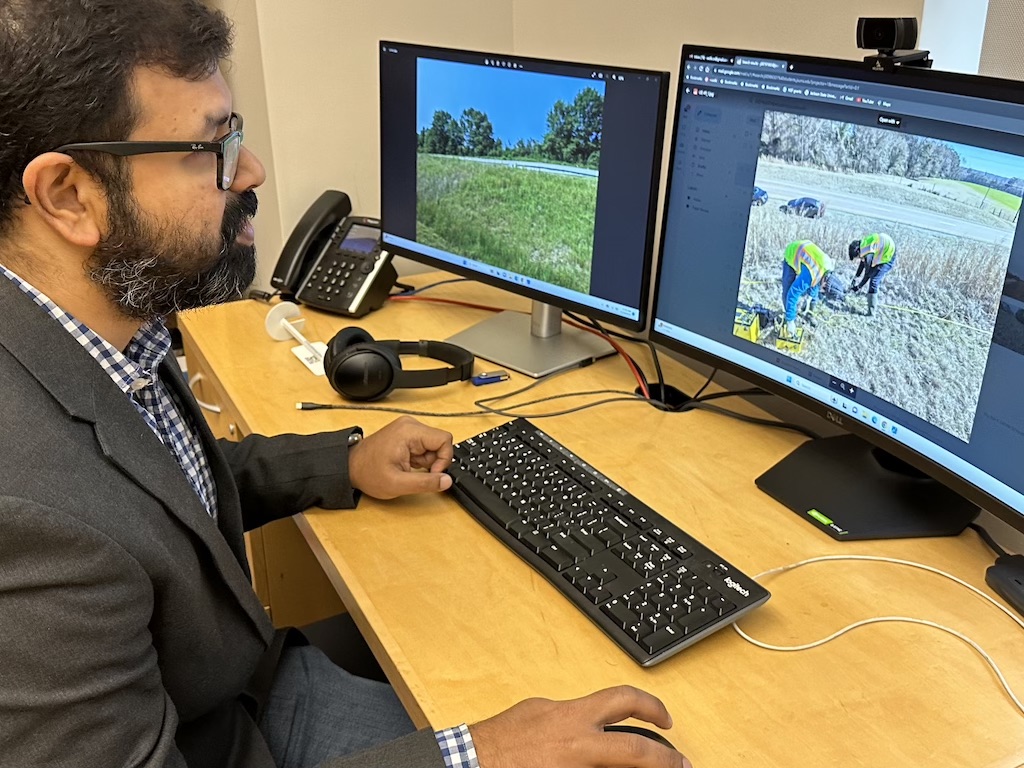By L.A. Warren
Researcher Sadik Khan, Ph.D., an associate professor in the Department of Civil and Environmental Engineering at Jackson State University, is investigating the use of vetiver grass as a solution to soil erosion and landslide repair. Using a prestigious CAREER grant from the National Science Foundation, he collaborates with the Mississippi Department of Transportation to develop a climate-resilient solution for landslide repair.
The NSF CAREER grant (Award # CMMI 2046054) supports early-career faculty as academic role models in research and education. Khan and his students began examining the characteristics of vetiver grass in 2019 for its root strength, water absorption abilities and its behavior in different seasons. Eventually, his team approached MDOT about its slope-failure investigation. They discovered that most failures happen from six to eight years after construction and after substantial rainfall. Beforehand, no one previously had measured the frequency of rainfall affecting MDOT slopes in Mississippi.
Working with MDOT, the JSU team tested a small slope at U.S. Interstate 20 and Terry Road in Jackson, Mississippi, where a landslide once had occurred. Despite traditional repairs using pile pipes, the area still experienced some movement. Meanwhile, promising results by the team were achieved using 2,035 vetiver grasses, covering a 30-foot by 50-foot area. “We used vetiver grass for shallow areas, not as a full-scale repair. Still, it helps to prevent deep-seated failures,” Khan said.
Another repair was performed at U.S. Highway 49 in Mount Olive, covering a 50-foot by 40-foot area with 5,000 vetiver grasses. Khan said, “Initially, we saw some movement because vetiver takes time to grow. Within the first month, the grass will be establishing its roots. By the third month, the roots extend about four feet. Generally, it takes a year to have a root depth of up to 10-12 feet. Once it is produced, the extremely survivable grass is low-maintenance. When you cut it, it restores its strength and produces new leaves. It’s perennial.”
Despite its many other applications (aromatic and aesthetic), vetiver grass is still relatively unknown and hasn’t been researched extensively, Khan said. “It was tested in some parts of Puerto Rico and the West Indies, but not on the mainland.” Vetiver is also praised as a “carbon negative (sequestration) solution,” which means the grass can isolate CO2 from the atmosphere and store that carbon in the soil while being used for slope repair. Vetiver absorbs heavy metals and other toxic materials from the soil and stores those elements in its roots. JSU purchases vetiver grass from nurseries in Louisiana, Puerto Rico, and Texas.
For MDOT, the research appeared to have been an Eureka moment as it had not considered such a method for improving some site flaws. In the future, this approach could potentially serve as a sustainable and cost-effective alternative to pipe piles, drilled shafts, or retaining walls. It’s also a proactive response to soil erosion and slope failure.
Khan added, “To sustain slopes, we can use traditional methods like installing drains, pipes or concrete, but it’s expensive.” He noted that the prevalence of Yazoo clay on slopes is problematic. “In Mississippi and neighboring states, fat clay is strong when it’s dry but difficult to work with when it’s damp, eventually losing its strength. This dynamic wreaks havoc on slopes, causing the soil to shift and leading to failure. “Because rainwater infiltrates slopes, we need a way to remove the water,” he said.
Consequently, Khan and his team discovered that “if we plant vetiver grass, which has a high tensile fiber strength, we can keep the soil in place. When water enters the soil via cracks caused by drought, for example, the highly distributed root system of vetiver grass acts like a sponge, draining out the water. It’s a transformative solution at an extremely low cost, especially when compared to the time it takes to complete the repairs and over $1 million in cost for a detailed landslide project.”
Pointing to climate change, Khan further expressed concern about the soil and potential landslides due to the recent drought in Mississippi. He said the temperature in Jackson has already increased close to the 2-degree Fahrenheit margin in which a 2-degree rise in global temperature is considered dangerous.
Nevertheless, Khan said vetiver grass not only addresses soil erosion and slope failures but also contributes to environmental sustainability and climate change adaptation. “Its versatility, low cost, and eco-friendly characteristics make it a promising solution from infrastructure repair to aesthetic landscaping to environmental remediation.”







